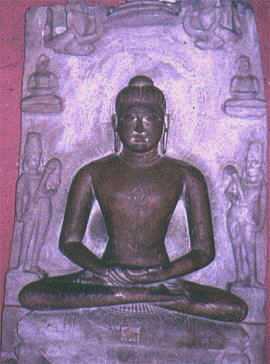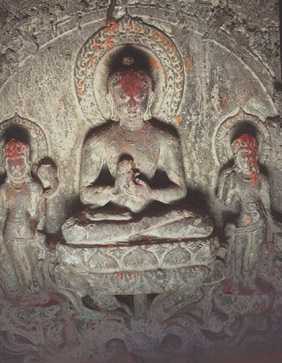
BUDDHISM IN HISTORICAL CONTEXT THE INDUS VALLEY CIVILISATIONPeople of the Indus Valley Civilisation (also called Harappan Civilisation after the major city of Harappa) were mainly farmers, although recent finds are indicating a well developed culture. Eminent scholars have concluded that the origins of the practices of yoga and meditation can be traced to the Indus Valley civilisation. An image of a human figure has been found that is seated in a cross-legged posture, hands resting on the knees and eyes narrowed - clearly suggesting meditation. Also, the wandering ascetic is frequently mentioned. These ascetics are said to have practised methods of mind training, to have been celibate, naked or clothed in the most meagre of garments, to have had no fixed abode, and to have taught a way beyond birth and death. THE ARYANSAccording to most scholars, the original Indus Valley civilisation was abruptly interrupted sometime between 1800 and 1500 BCE by an invasion of the Aryans (people from a region somewhere in Eastern Europe). These were warriors and traders, as opposed to the original population of farmers. After the middle of the second millennium BCE, Indian society became largely dominated by Aryan values. Many of the Aryan principles still dominate "orthodox Indian philosophy" and present-day Hinduism; such as the importance of the Vedic scriptures and the supremacy of the Brahmic class (origins of the caste-system). A simplistic overview of the contrast between the Indus Valley and Aryan culture is given in below table.
SCHOOLS OF THOUGHT CONTEMPORARY TO THE BUDDHAFrom about 1500 to 600 BC much interaction of above opposed
traditions occurred. The religious and philosophical world at the time of
the Buddha With the risk of oversimplifying things, one could say that Jainism
and Buddhism are mainly further developments of the principles of the Indian
Valley Culture, whereas the "orthodox schools of Indian (Hindu) philosophy"
were leaning more to the Aryan culture.
Three basic principles rule the orthodox schools of Hinduism:
1. Belief in an eternal, infinite, all-embracing neuter principle of ultimate reality called Brahman. The pervasive force lying within all beings, Brahman is conceived as the "self," or atman, of all forms of life. 2. Supremacy of the sacred texts like the Vedas (probably composed about 1500-1200 BC)and Upanishads (c. 400 BC). 3. Supremacy of the Brahman (priestly) class as the highest representative of religious purity and knowledge, and many support the notion that social and religious duties are differently determined according to birth and inherent ability. Various schools of Hinduism were developing during the
time of the Buddha, like Mimamsa, Vedanta and Samkhya (see below).
Theistic Hinduism replaced the Vedic sacrificial cult with a form of worship or service to an image or representation of the deity called puja and an attitude of respectful, but often enthusiastic, devotion called 'bhakti'. Puja consists of a more or less elaborate ritual in which the deity is invoked into an image that is established in either the home or temple, is honoured as a royal guest with a seat, offerings of water, garments, perfumes, flowers, food, and so on, and is then dismissed out of the idol he has temporarily deigned to inhabit. The main purpose of the ritual is the communion with the deity gradually leading to a more permanent and even closer relationship between the worshiper and God. The main deities worshipped in Hinduism are: Vishnu, Shiva and Shakti. Many of the other deities within the Hindu pantheon are worshipped on occasion, either on specific dates or depending on the need of the practitioner. Most schools of Hinduism (still) emphasise aspects inherited
from the Aryan tradition like; caste, the authority of scriptures like the
Vedas, and the practice of sacrifice . However, important elements of the
culture of the Indus Valley civilisation., such as renunciation, meditation,
rebirth, karma, and liberation have also been absorbed. Mahavira (Great Hero) lived around 570-490 BC and was a contemporary of the Buddha. He is considered the main prophet (Tirthankara) who founded Jainism in this era. Similar to Buddhism, Jainism teaches that their principles have been taught in the past by enlightened teachers, and will be taught again in the future. The main principles of Jainism could be summarised as: There are many similarities between Jain and Buddhist philosophy, like a belief in karma, detachment, meditation and relativity (realisation that there is always more than one viewpoint). Also less obvious aspects appear similar, for example the similarity of the cosmology in the Kalachakra Tantra). Often, it is not even easy to distinguish between an ancient depiction of the Mahavira and the Buddha, as they are both usually depicted in a similar meditation posture, like below left the image of the Mahavira and at the right the Buddha. The most obvious difference is the fact that the Jain saints are naked.
To illustrate the Jain concept of relativity of different viewpoints, they use the parable of 5 blind men trying to experience an elephant by means of touch.
Jainism teaches, that once the person has applied the three principles of detachment, karma and relativity, he or she can experience and share Maitri which is pure love, understanding and compassion for all beings (an extremely important aspect of Mahayana Buddhism). Moreover, as described in the jainsamaj webpage:
OTHER PHILOSOPHIESBesides these well-known religions, other - and often quite
radical - philosophies were known at the time of the Buddha, although not
existing anymore at present, like: BUDDHISM A PROTEST TO HINDUISM OR AN OFFSHOOT?Few scholars would disagree that at the time of the Buddha,
a very heterogeneous and actively developing religious culture flourished
in India. This generally accepted historical reality proves that Buddhism
was neither a protest against, or an offshoot of Hinduism (this view is even
expressed for example in the Encyclopaedia Brittanica). Buddhism simply proved
to be one of the more successful new schools of thought within a large variety
of philosophies, especially after King Ashoka became a Buddhist in 297 BCE,
and turned it into a state religion. It appears that Buddhism draws most of its inspiration from the religious culture of the Indus Valley civilisation; like the elements of renunciation, meditation, rebirth, karma, and liberation. Also, many symbols of the Indus Valley civilisation. have religious significance and are also sacred to Buddhism. They include the pipal tree (later known as the bodhi tree, or ficus religiosa), and animals such as the elephant and deer. On the other hand, aspects similar to the Aryan tradition can be clearly traced in the rituals of tantric Buddhism. This in contrast to Hinduism, where many of the Aryan principles dominate, although it also contains various elements of the Indus Valley Culture. BUDDHA AS REINCARNATION OF VISHNUVishnu is a Hindu god thought to incarnate in various forms called Avatars. One is the hero-king, Rama who battled the demon Ravana with the aid of Hanuman (the monkey-headed hero), another is Krishna who is depicted as a blue flute-player and a lover of many women each of whom feels she is the only one. Since the Buddha is considered by many Hindus (not by Buddhists!) to be one of the Avatars, Hinduism and Buddhism will probably always remain quite interlinked. LinksMain sources for this page:
|

